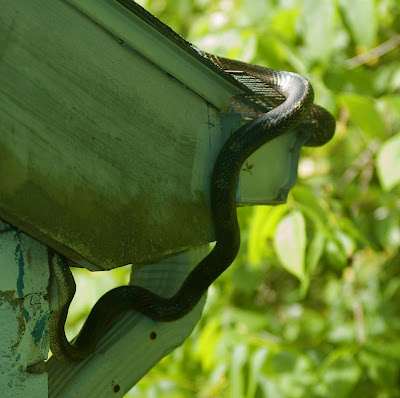
I was distracted, sitting cross-legged in the grass just beyond the pasture—sunlight cast upon dewdrops, the finest glassy beads adorning burs…
A perfect picture for the taking, my back turned to the tall grass rimming the barn.

I can’t say exactly what turned my attention to him. For he sat motionless watching me through the tall strands.
A Black Rat snake.
And of good size.
Like Fred, but not Fred.
The day before, I’d found 2 young crossing the lawn, their gray and brown camouflage different from the black back, white belly of the adults. But having the same docile nature—and equally inquisitive climbers.

 Warmed by the sun into activity.
Warmed by the sun into activity.
Last fall’s hatchlings.
Pretty little things.
Black rat snakes can grow to 8 feet, but we seldom see them reach that. Often hit on the roads in this rural area by drivers that erroneously see their crossings as opportunities to kill a nuisance, they’re great mousers. And on our property with its many outbuildings, well fed.
Within an hour he was accustomed to my touch. Quite an armload at almost 5 feet, he held on tightly as I walked around the yard—strong constrictor muscles from his head to the tip of his tail. Smelling and exploring this human who seemed to be nothing more than a substitute for a tree. His tail gripping my camera strap. Around and around he went.
Smelling and exploring this human who seemed to be nothing more than a substitute for a tree. His tail gripping my camera strap. Around and around he went.
Until I stopped at the farm fence—his invitation to dismount—and continued his hunting in the grass.
I hadn't found a snake as magnificent as Fred in 10 years.
We don't hang out together as much as I'd like. Fred takes his work of patrolling the attic space very seriously.
He prefers to hang out with the drainpipe.
Friday, May 30, 2008
Fred's friends
Thursday, May 29, 2008
Hanging by a thread
I paused for a minute as I came out of the barn--my eyes squinting as they slowly adjusted to the bold, bright light.
I'd been scouting the rafters for nests.
Earlier, I'd heard a Phoebe in this pasture, her raspy "fee-bee" alerting me to the fact she was close. Again.
Last year, she'd nested atop a light bulb just inside the goat stalls. And I 'd watched as her brood grew and fledged.
I hoped she'd returned.
But her spot was empty.
Standing beneath a small elm, I looked up.
Against the backdrop of fresh green leaves and blue sky, on the finest silk thread, a strange creature was suspended.
I watched as he lowered himself with a sudden drop, then, pulled himself back up, his white tangled line bunched into his face--almost to the very same spot.
Up and down.
On a silken cord.
Bird food.
Thanks to Wigger's World for hosting Skywatch Friday each week at his site!
Wednesday, May 28, 2008
Emergence

They're back!
Actually, they've been here all along. For the last seventeen years, that is, living beneath the ground, and feeding off the sap from tree roots.
Periodical cicadas emerge in "broods," groups sharing the same 13 or 17-year cycle, when the ground reaches about 64 degrees, usually in mid-May. But with this year's cooler spring, we found them appearing Monday. Smaller than the Dog-day cicadas of late summer, periodical cicadas are black, with bright red eyes.
And, although they may look pretty scary, they're harmless.
Some even say they're delicious!



If you live near one of these little red dots, you're probably seeing them too!
Dr. Gene Kritsky has more detailed information on his website.
Map copied from The Ohio State Cicada Project website.
Monday, May 26, 2008
Success with salamanders
This entry documents the final chapter of my experiences with Jefferson Salamanders. For previous entries, begin here.
“How many times do I have to tell you? Stop putting everything you find in your mouth!”
You’d think they’d have the sense to know food from non-food, but my little salamanders seem to explore their world by mouthing it.
Not a problem, as long as you can spit out what you don’t like.
A serious problem, if you can’t.
Last week, I peeked in the tank one morning to find two of the crew had something stuck, as in “hopelessly lodged,” in their mouths. One, in such a way that it prevented him from opening his mouth at all; the other--one preventing him from closing it. A sticky matter, indeed!
The seeds of the Nodding Bur-Marigold float at the surface, their back-curved barbs like fishhooks in tender skin. Apparently mistaken for food, they’d been gulped—and would go neither up nor down.
In a small bowl of water on the kitchen table, I operated on my 2-inch long patients—with a pair of tweezers and the utmost concentration. Barely restraining them until I could get a grip on the bur, then working it gently loose. Minutes later, they were swimming once again in the tank.
And, of course, hungry for breakfast.
A small mark, the only reminder of the nasty, spiny encounter.
This weekend, on a cool rainy evening, I released them back to Wood pool--the few Jefferson Salamander larvae, still with bright, smiling faces. (and several Wood Frog tadpoles)
At 45 days since hatching, they’re soon to metamorphose—lose gills, crawl out onto land, and begin their adult lives, underground. They’ll return to this very same pool for only a few days each spring to breed, reuniting with others of their kind in the icy March waters, before leaving eggs behind.
I wanted to be sure they came to know this pool as their home. And completed the cycle of life in these waters. This is their ancestral pool.
How far they’ll wander from here is unknown.
And how they navigate the distance for their return each spring is also unknown.
But one thing is certain—on a rainy night in late February, under a pitch-black sky--with my flashlight, I’ll be watching.
Waiting to welcome them home.


calculated the rate of survival for this species in the wild,
from hatching to metamorphosis to be 0.7% (less than one percent).
Thanks to Mrs. Nesbit for hosting ABC Wednesday!
Beyond words

Perhaps it is not the presence of language that defines brilliance,
but rather, the ability to create something which is beyond words.
Sunday, May 25, 2008
Camera shy
This weekend has brought us long-overdue sunshine and warmth.
And, finally, days to go walking and watching.
But, try as I might to catch more than a glimpse--the leafy woods hide them well.
A Great Blue Heron flaps off clumsily from the pond, toward the woods--no doubt, I have disturbed his frog breakfast, as I approach.
On the bank, a muddy trail is the only evidence that Mama muskrat was here, just moments ago, gathering greens for her kits. She hits the water with a PLOP. Deep swirls disturb the surface.
Above me in the apple tree, a White-eyed Vireo dances from branch to branch gleaning insects.

The shadowy shapes of five snapping turtles have gathered in the shallow arm of water. They see surprisingly well--and vanish instantly, as I stand watching. In the woods, a thin gray shape leaves quietly. The coyote, perhaps, not used to my being here. The last weeks of rain have kept me away more than I like. He must think these trails are his own.
A Field Sparrow is feeding her family this morning. Hidden in the tall growth beneath the small oaks, they answer her calls. I see nothing but the slightest movement in the grass, as they find each other--and she flies up and away for more.
Hidden in the tall growth beneath the small oaks, they answer her calls. I see nothing but the slightest movement in the grass, as they find each other--and she flies up and away for more.
The tree frogs are calling loudly from Little Pond pool. This wet spring pleases them. On its surface, damsel flies catching the morning sunlight.
On its surface, damsel flies catching the morning sunlight.

And a Yellow-breasted Chat calling from across the field.
Maybe another day's watching will find him.
Maybe not.
Saturday, May 24, 2008
1...2...3 Chickadee...dee...dee
These photos update a post starting here.












































%20copy.jpg)













